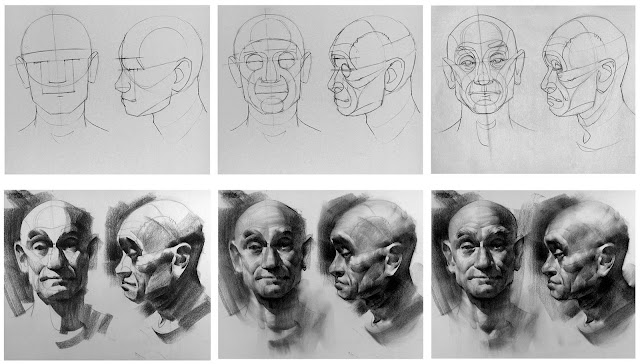3. Line Basics - Contour Lines
Some of this lesson comes from notes taken from this video by Stan Prokopenko on Youtube. Another source for this lesson was Drawing on the Right Side of the Brain, by Betty Edwards.
Contour lines follow the "contours", or edges, of shapes and forms - they are any line that goes along the edge of two different planes. They're most noticeable with outlines. All outlines are contour lines:
But, contour lines are also more than that, you can find contour lines inside shapes as well:
Digital artists use cross contour lines to divide the face into different planes and polygons:
I'm starting this course with contour lines, because they are what most people see and try to draw first - it's the most intuitive method of drawing. Contour lines have a proud tradition in art history, stretching back towards the beginning.
Ancient Sumerians drew contour lines:
Ancient Egyptians drew contour lines:
Ancient Greeks drew contour lines:
Contour lines are what we mostly use for creating symbols:
Contour lines are very popular in cartoons and comics:
Contour lines are great for creating silhouettes:
Contour lines can be quite sophisticated. Tom Scheuer uses them to mix and match positive and negative space:
Oliver Sin begins all his portraits with contour lines, to find the basic shapes, divide them into planes, and emphasize volume and depth. These kinds of lines are also called construction lines and land lines:
Nathan Fowkes does this too:
But, contour lines alone are not enough to draw successfully. When a beginner looks only at contour lines, and ignores the forms, the structure, the light, it's easy to get confused. The results look clumsy and flat - childlike.
Contour lines, alone, do not make great art, but they are a good place to begin. It's good to practice to draw contour lines. Just remember, there's more to learn.
Cross Contour Lines
These beautiful little lines are a great way to fix your drawings, adding structure, volume and perspective. These lines cross around your shapes, kind of like the lines on a basketball, indicating the forms. You should practice seeing and drawing cross contour lines to improve your ability.
Breaking Contour Lines
You can break a contour lines for various effects, to create depth and to integrate your subject into the background. In this drawing by Arthur Frost, the man's coat has a clear outline where the light hits him, but in the shadow, as the jacket wraps around behind him, the artist breaks up the lines into diagonal shading, softening the edge. This helps emphasize form, the roundness of his coat.
In this next example by Claire Wendling, the contour of the girl's leg is broken up by simple lines indicating grass. This places the subject in a natural, outdoor environment, even though no background was drawn.
LEVEL 1 ASSIGNMENT - Contour Drawing a Still Life from Observation
THE SET UP: pencil, paper, and some interesting still life objects - the simpler the better.
Gather together a small group of cups and bowls, and try drawing them, using only contour lines - no shading. Consider which objects are larger and smaller, taller and squatter, thinner and wider, etc. Try to draw what you see, as accurately as possible.
TIP 1: DRAW LIGHTLY! Don't worry about making each line perfect from the start, that's silly. Draw lightly to start, and go over later, when the shapes feel right.
TIP 2: DRAW BIG! Use the whole piece of paper.
TIP 3: If you draw a straight (plumb) line going up through the middle of each object (see example above), it helps you check if they're symmetrical.
LEVEL 1 ASSIGNMENT - Blind Contour Drawing Still Life
THE SET UP: A still life to observe, paper, pencil, and a brown paper bag.
Draw anything above but, put your paper/sketchbook in a brown paper bag so you can't see what you're drawing. Feel around with your hand to try to get a sense of the amount of space in there, and draw what you see, trying to put the basic lines of the object in the right places on the paper. You can try drawing just one long contour line, connecting the objects together, or work over areas repeatedly with lots of lines. This exercise is extremely difficult, but it's a Level 1 assignment because you're not expected to make a perfect drawing. This is really just good practice at seeing, and guessing sizes and proportions. Good luck!
LEVEL 1 ASSIGNMENT - Blind Contour Drawing Hand
THE SET UP: pencil, paper, and your hand
You draw your hand without looking at it. Just observe all the tiny cracks and wrinkles on the inside of your hand and follow them around the page, connecting them to the outlines of your fingers, etc. Don't worry if the result doesn't look realistic.
LEVEL 1 ASSIGNMENT - Taking a Line for a Walk
THE SET UP: paper and pencil, a view (or photo) of a city skyline.
Try to follow the skyline of a series of buildings, using one contour line. You can draw a city, a suburban street with houses and trees, a shopping center. It doesn't matter where. Draw from life or from photos, either way it's a good way to practice measuring.
LEVEL 2 ASSIGNMENT - Cross-Contour Line Still Life
THE SET UP: Paper, pencil, and a few still life objects
Choose a few simple objects, with geometrical forms, and draw them, using contour lines and cross contour lines.
LEVEL 2 ASSIGNMENT - Draw a Building from Observation
THE SET UP: Find any building you like, a house, store, sky scraper, doesn't matter. Try to draw it, looking for contour lines.
TIP 1: Line Up Your Windows - try one long line for all the windows (drawing lightly), and then cut them up, spacing them evenly. Seeing how they line up will help get them in proper proportion and perspective.
LEVEL 3 ASSIGNMENT - Master Studies
THE SET UP: Look at the following master drawings, by Tom Scheuer, Oliver Sin, Nathan Fowkes, and Egon Schiele. Try to draw them yourself, looking at them upside down:
LEVEL 3 ASSIGNMENT - Contour Line Portraits in the Style of the Masters
THE SET UP: Paper, pencil, and either a model (someone willing to sit for you) or a good photograph. Try for a 3/4 angle view of the model.
Try to draw a portrait of anyone, either from the images in this lesson, or of someone you know, using the same kinds of lines as Oliver Sin, Nathan Fowkes, or Tom Scheuer.
NOTE: If you get really good at this, congratulations, you're ready to work professionally.










































Comments
Post a Comment